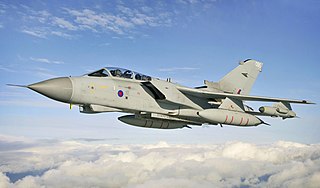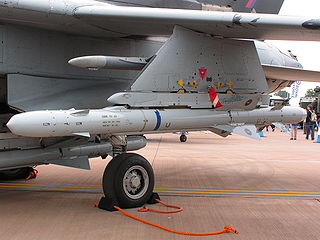British Aerospace plc (BAe) was a British aircraft, munitions and defence-systems manufacturer that was formed in 1977. Its head office was at Warwick House in the Farnborough Aerospace Centre in Farnborough, Hampshire. It purchased Marconi Electronic Systems, the defence electronics and naval shipbuilding subsidiary of the General Electric Company, in 1999 to form BAE Systems.
Marconi Electronic Systems (MES), or GEC-Marconi as it was until 1998, was the defence arm of General Electric Company (GEC). It was demerged from GEC and bought by British Aerospace (BAe) on 30 November 1999 to form BAE Systems. GEC then renamed itself Marconi plc.
The General Electric Company (GEC) was a major British industrial conglomerate involved in consumer and defence electronics, communications, and engineering.

The Panavia Tornado is a family of twin-engine, variable-sweep wing multi-role combat aircraft, jointly developed and manufactured by Italy, the United Kingdom and Germany. There are three primary Tornado variants: the Tornado IDS (interdictor/strike) fighter-bomber, the Tornado ECR SEAD aircraft and the Tornado ADV interceptor aircraft.

The Panavia Tornado Air Defence Variant (ADV) is a long-range, twin-engine swing-wing interceptor aircraft developed by the European Panavia Aircraft GmbH consortium. It was a specialised derivative of the multirole Panavia Tornado.

ALARM is a British anti-radiation missile designed primarily to destroy enemy radars for the purpose of Suppression of Enemy Air Defenses (SEAD). It was used by the RAF and is still used by the Royal Saudi Air Force. The weapon was retired by the UK at the end of 2013.

Panavia Aircraft GmbH is a German company established by the three partner states of the Tornado Multi Role Combat Aircraft (MRCA) project: West Germany, Italy and the UK.

The Thermal Imaging Airborne Laser Designator (TIALD) was a targeting pod manufactured by Ferranti/GEC Marconi in the late 1980s and 1990s, and was the UK's primary laser designator for its Paveway series of laser-guided bombs (LGBs).

The Euroradar Captor is a next-generation mechanical multi-mode pulse Doppler radar designed for the Eurofighter Typhoon. Development of Captor led to the Airborne Multirole Solid State Active Array Radar (AMSAR) project which eventually produced the CAESAR, now known as Captor-E.

The Skyflash, or Sky Flash in marketing material, was a medium-range semi-active radar homing air-to-air missile derived from the US AIM-7 Sparrow missile and carried by Royal Air Force McDonnell Douglas F-4 Phantoms and Tornado F3s, Italian Aeronautica Militare and Royal Saudi Air Force Tornados and Swedish Flygvapnet Saab Viggens.

Ferranti or Ferranti International PLC was a UK electrical engineering and equipment firm that operated for over a century from 1885 until it went bankrupt in 1993. The company was once a constituent of the FTSE 100 Index.
The Marconi Company was a British telecommunications and engineering company that did business under that name from 1963 to 1987. Its roots were in the Wireless Telegraph & Signal Company founded by Italian inventor Guglielmo Marconi in 1897, which underwent several changes in name after mergers and acquisitions. The company was a pioneer of wireless long distance communication and mass media broadcasting, eventually becoming one of the UK's most successful manufacturing companies. In 1999, its defence equipment manufacturing division, Marconi Electronic Systems, merged with British Aerospace (BAe) to form BAE Systems. In 2006, financial difficulties led to the collapse of the remaining company, with the bulk of the business acquired by the Swedish telecommunications company, Ericsson.
Thales Underwater Systems or TUS is a subsidiary of the French defense electronics specialist Thales Group. It was created in 2001 and belongs to its naval division. It specializes in the development and manufacturing of sonar systems for submarines, surface warships and aircraft, as well as communications masts and systems for submarines. Its headquarters are located in Sophia Antipolis, France.
BAE Systems Avionics was the avionics unit of BAE Systems until 2005, at which time it was transferred to SELEX Sensors and Airborne Systems S.p.A.. Selex S&AS became SELEX Galileo in 2008 and from January 2013 traded as Selex ES. It then merged into Leonardo S.p.A.'s land and naval defence electronics division on 1 January 2016.

SELEX Sistemi Integrati S.p.A. was an aerospace, defence and security-related electronics manufacturing company headquartered in Rome, Italy and a wholly owned subsidiary of Finmeccanica. It designed and developed systems for homeland security; systems and radar sensors for air defence, battlefield management, naval warfare, coastal and maritime surveillance; air traffic control; and turn-key airport solutions. The company had around 4,500 employees. On 1 January 2013, it merged with its sister companies SELEX Galileo and SELEX Elsag to form Selex ES.

The British Aerospace Nimrod AEW3 was a proposed airborne early warning (AEW) aircraft which was to provide airborne radar cover for the air defence of the United Kingdom by the Royal Air Force (RAF). The project was designed to use the existing Nimrod airframe, in use with the RAF as a maritime patrol aircraft, combined with a new radar system and avionics package developed by Marconi Avionics.

Blue Vixen was a British airborne radar designed and built for the Royal Navy by Ferranti Defence Systems, Edinburgh, Scotland. It was the primary radar of later models of the British Aerospace Sea Harrier, replacing the Ferranti Blue Fox used on earlier models of the Harrier.
The RDM (Radar Doppler Multifunction), also known as the Cyrano 5, is a French multimode pulse-Doppler radar developed by Thomson-CSF (now Thales) for export variants and early French models of the Mirage 2000 fighter aircraft. It is an evolution of the Cyrano IV installed on the Mirage F-1 and in turn was developed into the RDI (Radar Doppler à Impulsions), a specialist air-to-air radar for French Mirage 2000 interceptors, and the multimode RDY (Radar Doppler Multitarget), which could track more targets at a time and added further air-to-ground modes.

Aircraft interception radar, or AI radar for short, is a British term for radar systems used to equip aircraft with the means to find and track other flying aircraft. These radars are used primarily by Royal Air Force (RAF) and Fleet Air Arm night fighters and interceptors for locating and tracking other aircraft, although most AI radars could also be used in a number of secondary roles as well. The term was sometimes used generically for similar radars used in other countries, notably the US.
The ARI.23246/1 Sky Shadow is a radar jamming system, initially developed by GEC-Marconi Defence Systems, formerly operated by the Royal Air Force (RAF).












